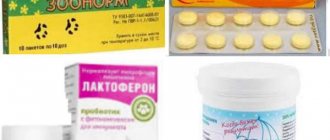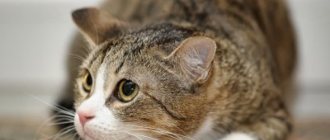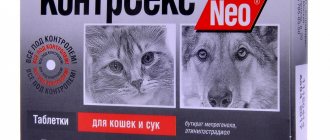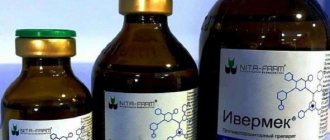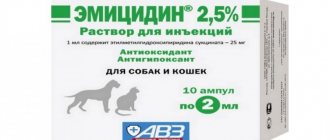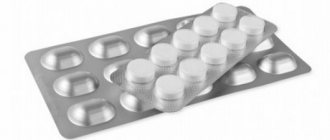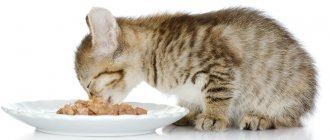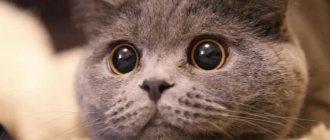Ceftriaxone is an antibacterial agent that is widely used to treat infectious processes caused by the activity of pathogenic microorganisms. The drug has gained wide popularity both in the treatment of human diseases and in veterinary practice. This is an effective, potent medicine that requires caution in use and compliance with medical recommendations. How is Ceftriaxone used for cats , and what do animal owners need to know about this drug?
Ceftriaxone for cats
General description of the drug
Ceftriaxone is a third-generation antibiotic from the cephalosporin family, which inhibits the activity and proliferation of pathogens. By suppressing the synthesis processes occurring in the walls of bacteria, it quickly destroys foreign agents, has a long-lasting effect and is effective against pathogens of a number of diseases.
Ceftriaxone is a third generation cephalosporin antibacterial agent.
The main active ingredient of the drug is ceftriaxone (sodium salt). The drug is used for intramuscular administration, available without a prescription in the form of a white, milky or yellowish powder, which is packaged in transparent bottles of 0.25, 0.5 or 1 g. It is diluted with a special liquid in combination with anesthetics - novocaine or lidocaine, after which administered intramuscularly according to the regimen prescribed by the doctor.
For reference! Ceftriaxone is available exclusively in the form of a powder for intramuscular injection, so if you cannot give injections to your animal for any reason, you need to consult a veterinarian to replace the drug with another one.
Average price for Ceftriaxone
Now let’s figure out how much the drug ceftriaxone costs in the Russian Federation.
In the central part of Russia, the cost of 1 g of the drug will be about 19-24 rubles. In Siberian cities the price varies from 24 to 29 rubles. In the Far East, medicine is bought for 29-45 rubles. In the south of Russia the price is 19-30 rubles.
What cat diseases are treated with Ceftriaxone?
The antibiotic is a broad-spectrum agent and is effective against many pathogenic microorganisms - these include various cocci (staphylococcus, pneumococcus, streptococcus), as well as E. coli, Legionella, Klebsiella, etc. Ceftriaxone injections are indicated for cats with infectious, inflammatory and septic processes caused by microorganisms sensitive to the effects of the active substance. Indications for the use of antibiotics include infections of the following organs:
- digestive tract;
- bone and nerve tissue (osteomyelitis, meningitis);
- urinary and reproductive system;
- respiratory and ENT organs.
What are antibiotics and what are they?
In addition, Ceftriaxone is often prescribed to cats after bites from other animals along with anti-rabies therapy and to prevent postoperative complications during castration, sterilization and other surgical interventions.
The drug is prescribed exclusively by a veterinarian, taking into account the clinical course of the disease, age, characteristics of the animal’s body and other factors. You cannot prescribe Ceftriaxone on your own - it can cause serious harm to the cat’s health, and also cause bacteria to become resistant to the active substance, which will make it much more difficult to cure the disease.
The drug has a wide spectrum of effects and is recommended for various infectious diseases
Attention! Despite the wide spectrum of action and effectiveness of Ceftriaxone, it is useless against Bacteroides fragilis, enterococci and some varieties of Staphylococcus aureus.
How it works and when to use it
Ceftriaxone is a third-generation antibiotic from the cephalosporin series. The principle of its action is that it prevents the synthesis of cell membranes in pathogenic microorganisms. As a result of this action, the microbes die. The antibiotic begins to act 2-3 hours after introduction into the body. Together with the bloodstream, it spreads throughout the body and is excreted mostly by the kidneys.
The drug is effective against various bacterial infections:
- staphylococcus;
- streptococci;
- coli;
- proteas;
- enterococcus;
- salmonella, etc.
Treatment of cats with Ceftriaxone is recommended in the following cases:
- with otitis;
- for sepsis;
- for bronchitis, pneumonia and other infectious diseases of the respiratory tract;
- for cystitis and other bacterial inflammations of the genitourinary system;
- when affected by infection of the liver and biliary tract;
- with chladimiosis;
- with meningitis;
- for osteomyelitis and other bone pathologies of bacterial origin;
- for infectious inflammation of soft tissues;
- for gastrointestinal infections;
- for other pathologies caused by antibiotic-sensitive microorganisms.
The medicine is also prescribed in the postoperative period to prevent complications in the form of bacterial infections.
How to use Ceftriaxone for cats
According to the instructions for use, it is necessary to prepare a solution for intramuscular administration from Ceftriaxone powder according to certain rules.
- For Ceftriaxone therapy, it is necessary to additionally purchase ampoules of sterile water for injection and novocaine. Dry granules are diluted at the rate of 1 g per 2 ml of water and 2 ml of novocaine - the resulting product contains approximately 250 mg of the active substance.
To reduce pain during injection, Ceftriaxone is diluted with novocaine
- To prepare a solution for intramuscular injection, you need to draw sterile water and novocaine into a syringe, insert the needle into the container with the powder through the rubber cap, after removing the protective sheath, and release the liquid. Shake the bottle slightly so that the dry and liquid components mix well, resulting in a clear yellowish solution (a small amount of sediment is acceptable).
- Change the needle, draw the required amount of solution into the syringe - the standard dosage is 0.5 ml of the finished product with a weight of less than 2 kg, if the cat’s weight exceeds 2 kg, you will need 1 ml, then give the pet an injection.
Ceftriaxone is quickly and almost completely absorbed by the body, after which it is carried along with the bloodstream, penetrates all tissues and has a prolonged effect, so it is administered to the animal once a day, the course of treatment is 1-2 weeks.
The drug can be mixed with sterile water for injection without the use of anesthetics, but in this case the injections will be extremely painful. Lidocaine is often used to prepare the solution, which has a more pronounced analgesic effect, but when treating cats it is better to use novocaine. Lidocaine often causes allergic reactions in cats, including anaphylactic shock and has a negative effect on the cardiovascular system.
Attention! Ceftriaxone can be injected into cats only intramuscularly - subcutaneous injections are strictly prohibited.
Video -How to dilute an antibiotic for injection
Ceftriaxone Veterinary antibiotic
Crystalline powder, almost white or yellowish in color.
1 bottle contains the active ingredient:
ceftriaxone sodium salt - 1.0 g.
Pharmacological properties
Ceftriaxone is an antibiotic of the beta-lactam group, a third-generation cephalosporin with a bactericidal effect. The mechanism of action of the drug is associated with inhibition of the activity of the enzyme transpeptidase, disruption of the biosynthesis of peptidoglycan in the cell wall of microorganisms.
The drug has a wide spectrum of action: it is active against gram-positive aerobic: Staphylococcus aureus (including strains that produce penicillinase), Staphylococcus epidermidis, Streptococcus pneumoniae, Streptococcus pyogenes, Streptococcus viridans; gram-negative aerobes: Enterobacter aerogenes, Enterobacter cloacae, Escherichia coli, Haemophilus influenzae, Haemophilus parainfluenzae, Klebsiella spp. (including K. pneumoniae), Moraxella catarrhalis, Morganella morganii, Neisseria gonorrhoeae, N. meningitidis, Proteus mirabilis, Proteus vulgaris, Serratia spp. (including Serratia marcescens), Acinetobacter calcoaceticus, Pseudomonas aeruginosa; obligate anaerobes: Bacteroides fragilis, Peptostreptococcus spp., Clostridium spp. (except Clostridium difficile).
It is also active against most strains of the following microorganisms: Providenda spp., Bacteroides bivius, Bacteroides melaninogenicus, Salmonella spp. (including Salmonella typhi), Shigella spp., Streptococcus agaladiae, Providenda rettgeri, Citrobacter freundii. The drug is prescribed when the microflora is resistant to other cephalosporin drugs, aminoglycosides, penicillins, etc. After administration, the drug is absorbed quickly and completely. The bioavailability of the substance is about 100%.
Application
Treatment in dogs and cats of diseases of the respiratory system, genitourinary system, skin, soft tissues and bones, otitis media, sepsis, meningitis caused by microorganisms sensitive to ceftriaxone; prevention of postoperative complications.
Dosage
The drug is administered intramuscularly or intravenously once a day.
For intramuscular administration to dogs, the contents of one bottle (1.0 g of the drug) are dissolved in 3.6 ml of 1% lidocaine solution or 0.25%-0.5% novocaine solution or sterile water for injection. 1 ml of the solution prepared in this way contains about 250 mg of ceftriaxone.
For administration to cats, the contents of one bottle are dissolved in 3.6 ml of 0.25% -0.5% novocaine solution or sterile water for injection. When used in cats, the drug should not be diluted with lidocaine. 1 ml of the solution prepared in this way contains about 250 mg of ceftriaxone.
For intravenous administration, the contents of the vial are dissolved in 9.6 ml of sterile water for injection or 0.9% sodium chloride solution or 5% glucose solution. 1 ml of solution prepared in this way contains about 100 mg of ceftriaxone.
For drip administration, the contents of the bottle are dissolved in 100-250 ml of 0.9% sodium chloride solution or 5% glucose solution. The infusion of the prepared solution is carried out for 20-30 minutes at an injection rate of 60-80 drops per minute.
The daily dose of the drug is 20-40 mg of ceftriaxone per 1 kg of animal body weight. If necessary, the frequency of use can be increased to 2 times a day with a dosage of 10-20 mg of ceftriaxone per 1 kg of animal body weight. The course of use of the drug is 5-10 days, depending on the severity and course of the disease.
Contraindications
Hypersensitivity to drugs of the cephalosporin group and other beta-lactam antibiotics; renal or liver failure; pregnancy period.
Cautions
When dogs are treated with large doses of ceftriaxone, gallstones may form in the gallbladder. If you are hypersensitive to lidocaine, it is not recommended to use its 1% solution as a solvent.
Release form
Glass bottles, closed with rubber stoppers and aluminum caps for rolling, 1 g each, packed in cardboard boxes of 40 fl.
Storage
Dry, dark place, out of reach of children, at a temperature of 15 °C to 25 °C.
Shelf life: 3 years from the date of manufacture.
Information from the site: https://agroolkar.com.ua
How to give a cat an injection of Ceftriaxone
The drug is injected into the back of the animal's thigh using an insulin syringe - it has a short and thin needle, due to which the cat will feel less discomfort, and the risk of damage to soft tissues and nerve endings is reduced. The injection site is determined 2-3 cm above the joint of the hind paw on the outside. It is better to carry out the procedure together with an assistant - even when using Novocaine, Ceftriaxone injections remain quite painful, and the cat will probably struggle or use its claws and teeth.
- The cat should be well secured and gently, calmly talk to it.
- Lightly stretch the animal's paw to determine the thickness of the muscle tissue and select the location where the injection will be given.
- With a confident but gentle movement, insert the needle to a depth of 1-1.5 cm, holding the syringe at an angle of 45 degrees to the surface of the body, slowly release the solution, and treat the injection site with an antiseptic.
- Massage the thigh and calm the pet again.
Due to the fact that the administration of Ceftriaxone causes serious discomfort, it is better to administer it alternately: first into one, then into the other thigh.
The medicine is administered to cats in the thigh exclusively intramuscularly.
How to give a cat an intramuscular injection at home? Why learn to give injections yourself? Advantages and disadvantages of intramuscular injections. We select syringes and needles for injections for cats. How to properly restrain your cat before injection. Injection technique. Possible complications in a cat after the injection. You will learn about this by reading the material on our portal.
Video - How to give an intramuscular injection to a cat
What dosage to use
The dosage of Novocaine for cats must be strictly observed, otherwise you may end up with a new problem instead of treatment. The drug is available in the form of an injection solution. 100 ml of solution contains water and only 0.5 g of the active ingredient procaine hydrochloride. The dosage should be prescribed by a veterinarian and can range from 30 to 300 ml, depending on the disease and severity of the disease, as well as how many kg the cat weighs.
The solution output is usually standard from 20 to 100 ml. The drug should be stored in a dry, closed room. The shelf life is 3 years; after the expiration date, the use of the drug is prohibited and must be disposed of. You can replace Novocaine with Ledocaine, it will also have an analgesic effect, it can be called a local analgesic.
Contraindications and side effects
Ceftriaxone is a potent antibiotic, but has a small number of contraindications:
- severe renal and hepatic dysfunction;
- ulcerative lesions of the stomach and intestines;
- individual hypersensitivity to cephalosporin antibiotics.
Ceftriaxone is prescribed with caution for any disorders of the urinary system, since the active substance of the drug is partially excreted by the kidneys. The product has a pronounced teratogenic effect, so it is prohibited for use in pregnant and lactating females, as well as in kittens. At least 3 months must pass from the moment of treatment with Ceftriaxone until the animal is mated, otherwise the risk of negative effects on the offspring remains.
Ceftriaxone is contraindicated for use in kittens.
Ceftriaxone is usually well tolerated by the body, but sometimes the following undesirable effects may develop:
- disorders of the digestive system (vomiting, diarrhea, lack of appetite, flatulence);
- allergic manifestations;
- bronchospasm;
- itching, urticaria, hair loss;
- disorders of the kidneys and liver;
- changes in blood test results (decrease in the concentration of leukocytes, lymphocytes, etc.).
Side effects develop especially often in weakened and elderly animals, so they require special monitoring during treatment. At the site of injection of the solution, slight swelling or infiltration may be observed, which usually resolve on their own and do not require medical intervention.
Important! If, 2-3 days after the start of therapy, the cat does not show any improvement or serious side effects are observed, you should consult a doctor as soon as possible and replace the drug with another antibiotic.
Analogues of the drug according to indications for use
Ceftriaxone is an effective, accessible and relatively inexpensive drug - a standard bottle of powder (1 gram) costs about 30 rubles. But sometimes situations may arise when it is necessary to replace it with another medication of a similar spectrum of action, but having either another active substance or any other dosage form - for example, tablets.
Table: drugs similar to Ceftriaxone
| Drug name | Release form | Active substance | Contraindications | Manufacturer country | Estimated cost |
| Cefotaxime | powder for injection solution | cefotaxime anhydrous |
| India | 30 rubles for one bottle (1 g) |
| Spectraceph | pills | cefditoren |
| Japan | 1700 rubles per package (20 tablets) |
| Tsedex | capsules, suspension | ceftibuten |
| USA | 650 rubles per bottle of suspension |
| Rocephin | powder for injection solution | ceftriaxone |
| Switzerland | 520 rubles for one bottle (1 g) |
| Suprax Solutab | capsules | cefixime trihydrate |
| Jordan | 800 rubles per package (10 capsules) |
| Lorakson | powder for injection solution | ceftriaxone |
| Iran | 220 rubles for one bottle (1 g) |
Photo gallery: some antibiotics to replace Ceftriaxone
Lorazidim is a new generation injectable universal antibiotic
Ceraxon is used by injection (solution) and orally (solution and tablets)
Suprax capsules should be administered with caution to kittens and older animals
Cefotaxime is an inexpensive antibiotic made in India
Cedex is a drug for oral use
Spectracef should not be used if you are hypersensitive to the protein casein.
Rocephin contains ceftriaxone as its active ingredient.
How to replace Ceftriaxone
Ceftriaxone has a fairly large number of analogues, but you cannot replace one drug with another on your own - only a doctor can make adjustments to the treatment regimen, since each drug has its own characteristics, indications and contraindications.
Ceftriaxone has many analogues that have similar but rather weak effects
Table 1. Common Ceftriaxone analogues and their features.
| A drug | Peculiarities |
| Rocephin | An imported analogue of Ceftriaxone, it does not cause intense pain, is sold in pharmacies complete with a solvent, has a high quality and level of purification, but is much more expensive. |
| Amoxiclav | The active substance of the drug is amoxicillin in combination with clavulanic acid. It has virtually no contraindications and has a mild effect, but its therapeutic effect is much weaker. |
| Cefotaxime (Cefosin) | It has fewer side effects, unlike Ceftriaxone, it does not have a detrimental effect on bone tissue and the biliary function of the liver, and is approved for long-term use. The disadvantage is that the effect is rather weak. |
| Cephalexin | An oral analogue of Ceftriaxone, which belongs to the first generation of the same series of antimicrobial drugs. It is well absorbed by the walls of the stomach, quickly reaches a high concentration in the blood, under the supervision of a doctor it is approved for use in pregnant and lactating females, but in severe conditions the drug may be ineffective. |
| Suprax (Sorceph) | The drug belongs to the third generation of the cephalosporin series, is produced in several forms (tablets, powder for preparing a suspension), but, compared to Ceftriaxone, has a limited spectrum of action. |
Ceftriaxone is considered one of the most potent modern antibiotics, therefore, in case of serious pathological processes, veterinarians use it to achieve the maximum concentration of the active substance in the blood, and after the animal’s condition improves, they can switch to a milder analogue.
Is it possible?
For enteritis
Enteritis is deadly for dogs. As a rule, the disease is characterized by inflammation of the intestines, which can affect any part of the digestive tract. This disease can take the life of an animal in just a day, so it is extremely important to detect symptoms as quickly as possible and begin treatment immediately. Signs of infection:
- abdominal pain;
- diarrhea and vomiting (during the first day);
- sharp, unpleasant odor in vomit and feces;
It is immediately worth noting that without vaccination with a special serum with immunoglobulins, it will not be possible to cure an animal suffering from a viral form of enteritis.
Antibiotics are prescribed to treat the disease. Having a wide spectrum of action, Ceftriaxone has proven itself in the treatment of enteritis in dogs.
Under the influence of the drug, the activity of enzymes that ensure the strength of bacterial cell membranes is disrupted. The medicine prevents the development of re-infection and reduces the risk of complications of the disease.
For piroplasmosis
Piroplasmosis is a disease caused by parasites. When infected, the following symptoms are observed:
- temperature rises;
- appetite disappears, the animal gets tired quickly;
- the dog drinks a lot of water and becomes thirsty;
- dark color of urine;
- diarrhea;
- vomit;
- shaky, uncertain gait;
- rapid breathing;
Important! During the period of complications of the disease with a bacterial infection, Ceftriaxone is added as an antibiotic intravenously or intramuscularly. At a dose of 20-50 mg per kg of body weight per day.
For interdigital pyoderma
For interdigital pyoderma in dogs, Ceftriaxone is not used. Veterinarians more often prescribe antibiotics such as Baytril, Cephalexin, Enrofloxacin, Tyrosine, Clindamycin, etc.
For mycoplasmosis
Ceftriaxone is not suitable for the treatment of mycoplasmosis in dogs. For this disease the following are used: Erythromycin, Levomycetin, Doxycycline, Tylosin.
Is it used to treat fistulas?
Unfortunately, purulent inflammations - fistulas - are quite common in dogs, caused by the body's protective reaction.
A fistula is an area of purulent inflammation connected to the external environment through the fistula canal. Simply put, this is a small and narrow hole through which purulent masses are discharged out through the canal. The disease is similar to an ordinary abscess, but the inflammatory process is much more dangerous.
One of the main aspects in the treatment of fistulas in dogs is the use of broad-spectrum antibiotics. Ceftriaxone is well suited and often used to treat this disease.
Will it help if the mammary gland is swollen?
In a non-pregnant female, the mammary glands should not have any lumps, swelling, redness or discharge. In a pregnant animal, slight swelling of the glands is considered normal.
If the owner notices that the pet’s mammary glands have changed color, shape, become noticeably hardened, etc., then the animal should be examined as quickly as possible and find out what caused this pathology. Ceftriaxone is used to treat mammary glands in dogs, since the use of an antibiotic is indispensable.
Other indications
The drug is used to treat:
- bronchitis, otitis, sinusitis, laryngitis and other pathologies of the respiratory system;
- cystitis, pyelonephritis and other diseases of the genitourinary system;
- sepsis;
- infectious lesions of joints and bone tissue;
- purulent wounds;
- meningitis;
- salmonellosis and other bacterial diseases associated with digestion;
- blood poisoning, etc.
Reviews from pet owners about Ceftriaxone
The medicine has positive reviews from cat owners who treated their pets with this drug. Its high efficiency, wide availability and reasonable cost are noted, but in some cases, owners of four-legged patients have encountered the development of side effects. Animal owners say the key disadvantage of Ceftriaxone is the complexity and pain of its administration, which require some experience and skills.
Ceftriaxone has positive reviews from pet owners
Ceftriaxone is an effective antibiotic that has a wide spectrum of action and is often used in veterinary practice to treat infectious processes. The drug is a potent medication, so its use requires consultation with a specialist and careful monitoring of the animal’s condition.
Analogs
The product is so effective due to its active ingredient that analogues have appeared. Replace the medication only if you are intolerant or unable to give an injection. Anyway, ceftriaxone powder is considered the most effective antimicrobial agent.
global $ads_google; //data-ad-slot=”2475549904″ $ads_google = empty($ads_google) ? false : true; ?> if ($ads_google == false) {?>
$ads_google = true; ?> } ?>
Drug analogues:
- amoxicillin: tablets or injections, the effect of the drug is milder, but just as effective;
- Cephalexin: allowed for the treatment of pregnant cats, but requires medical supervision. This product is in capsules;
- sorcef: a convenient antimicrobial agent available in powder form for suspension and in tablet form. The activity is not as high as that of ceftriaxone;
- doxycycline: the medicine is not suitable for cats expecting offspring, as well as for kittens or cats that have a disorder of the musculoskeletal system.

